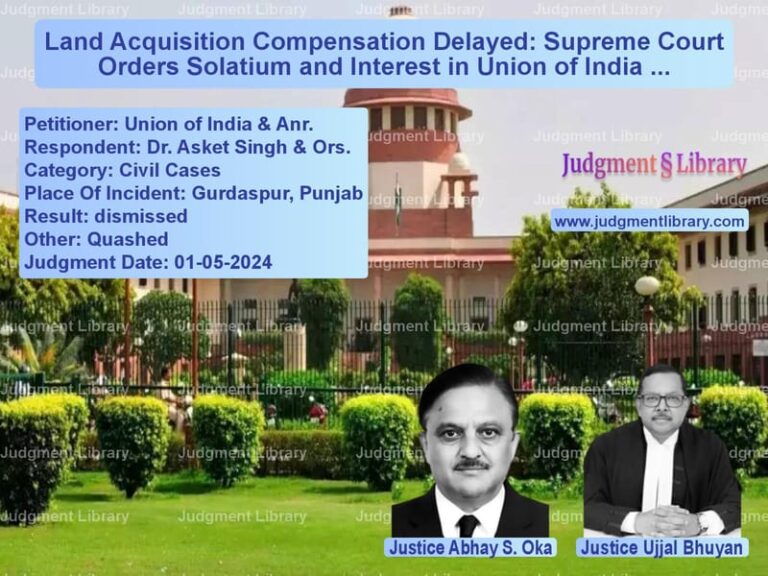Contempt of Court and Illegal Sealing: Supreme Court’s Verdict on Manoj Tiwari Case
The case of M.C. Mehta vs. Union of India & Ors. is a landmark judgment dealing with unauthorized construction, municipal governance, and contempt of court. The case arose when a sealing action carried out by the East Delhi Municipal Corporation (EDMC) under the supervision of the Supreme Court’s Monitoring Committee was challenged by a public representative. The case took a political turn when Manoj Tiwari, an elected Member of Parliament, allegedly broke the seal of an illegal dairy, defying court orders. The Supreme Court examined whether his actions constituted contempt of court and whether his public statements against the Monitoring Committee undermined the judiciary’s authority.
Background of the Case
The Supreme Court had, in an earlier order dated 16th February 2006, appointed a Monitoring Committee to oversee the implementation of municipal regulations in Delhi. The committee was tasked with ensuring that unauthorized commercial establishments in residential areas were sealed in accordance with the Delhi Municipal Corporation Act, 1957.
On 14th September 2018, officials from the Veterinary Services Department of EDMC sealed an illegal dairy operating in Gokalpur, Shahdara. The dairy was owned by Prem Singh and was found to be in violation of municipal laws. However, on 16th September 2018, digital and print media reported that Manoj Tiwari had broken the seal in public, allegedly taking the law into his own hands.
Petitioner’s Arguments
The case was brought to the Supreme Court’s attention by the Monitoring Committee, which submitted a report (No. 129) detailing the incident. The key points in the petition were:
- The breaking of the seal was a direct violation of court orders.
- Manoj Tiwari’s actions amounted to interference in the administration of justice, making him liable for contempt of court.
- Public representatives must lead by example and not take the law into their own hands.
- The act of breaking the seal had been widely publicized, with media reports showing him doing so in front of a large crowd.
- After the incident, Tiwari made public statements alleging that the Monitoring Committee was running a “sealing racket” in connivance with corrupt officials.
Respondent’s Arguments
Manoj Tiwari personally appeared before the Supreme Court and submitted a written response. His arguments were:
- He was under pressure from a large gathering of people who had assembled at the location.
- He claimed the seal had been placed illegally, justifying his actions.
- He defended his statements against the Monitoring Committee, arguing that he had a right to free speech and was merely expressing his opinion.
- He denied that he had any intention to interfere with court orders.
Supreme Court’s Observations
The Supreme Court, comprising Madan B. Lokur, S. Abdul Nazeer, and Deepak Gupta, made several critical observations:
- The Court emphasized that an elected Member of Parliament must lead by example and not violate the law.
- It noted that breaking the seal of an establishment was a direct defiance of the orders passed by the Court.
- The Court rejected the argument that Tiwari was forced to act due to public pressure, stating that a leader must pacify the crowd rather than yield to mob demands.
- The Court observed that making baseless allegations against the Monitoring Committee undermines judicial institutions.
- While the Court refrained from issuing a contempt ruling, it strongly condemned his actions.
Supreme Court’s Ruling
The Court issued a firm judgment on the case:
- Manoj Tiwari had violated the law by breaking the seal, but the Court exercised restraint and did not find him guilty of contempt.
- The Court left it to his political party to decide whether disciplinary action should be taken against him.
- The Monitoring Committee’s reports (Nos. 129 and 131) were closed with no further action.
- The Court condemned political posturing that undermines judicial authority.
Implications of the Judgment
The ruling sends a strong message regarding judicial oversight and political accountability. It highlights the need for political representatives to respect the rule of law and refrain from actions that weaken the legal system.
Conclusion
The Supreme Court’s verdict in this case serves as a reminder that public officials are not above the law. While no contempt ruling was issued, the judgment serves as a warning that violations of judicial orders will not be taken lightly. The case underscores the importance of maintaining public trust in judicial institutions and ensuring that all citizens, including elected representatives, abide by the law.
Petitioner Name: M.C. Mehta.Respondent Name: Union of India & Ors..Judgment By: Justice Madan B. Lokur, Justice S. Abdul Nazeer, Justice Deepak Gupta.Place Of Incident: Gokalpur, Shahdara, Delhi.Judgment Date: 22-11-2018.
Don’t miss out on the full details! Download the complete judgment in PDF format below and gain valuable insights instantly!
Download Judgment: M.C. Mehta vs Union of India & Ors Supreme Court of India Judgment Dated 22-11-2018.pdf
Direct Downlaod Judgment: Direct downlaod this Judgment
See all petitions in Public Interest Litigation
See all petitions in Fundamental Rights
See all petitions in Judgment by Madan B. Lokur
See all petitions in Judgment by S. Abdul Nazeer
See all petitions in Judgment by Deepak Gupta
See all petitions in dismissed
See all petitions in supreme court of India judgments November 2018
See all petitions in 2018 judgments
See all posts in Constitutional Cases Category
See all allowed petitions in Constitutional Cases Category
See all Dismissed petitions in Constitutional Cases Category
See all partially allowed petitions in Constitutional Cases Category







